
Reference Publication: Masiello, John A., Bouchelle, Matthew P., Parker, Danny S., Sherwin, John R,. "Measured Energy and Peak Demand Reduction from High Efficiency Air Conditioner Replacement," Presented at the 2004 ACEEE Summer Study on Energy Efficiency in Buildings, American Council for an Energy Efficient Economy, Washington D.C. August 2004. Disclaimer: The views and opinions expressed in this article are solely those of the authors and are not intended to represent the views and opinions of the Florida Solar Energy Center. |
Measured
Energy and Peak Demand Reduction from
High Efficiency Air Conditioner
Replacement
John
A. Masiello and Matthew P. Bouchelle
Progress Energy Florida,
Inc.
Danny S. Parker and John R. Sherwin
Florida Solar
Energy Center
FSEC-PF-379-04
Abstract
A utility load research project has monitored over 167 single-family residences in Central Florida collecting baseline 15-minute data on air conditioner (AC) power consumption, interior air temperatures and appliance loads over a two year period. Within the project we evaluated the impact of replacing older existing air conditioners with modern high efficiency equipment.
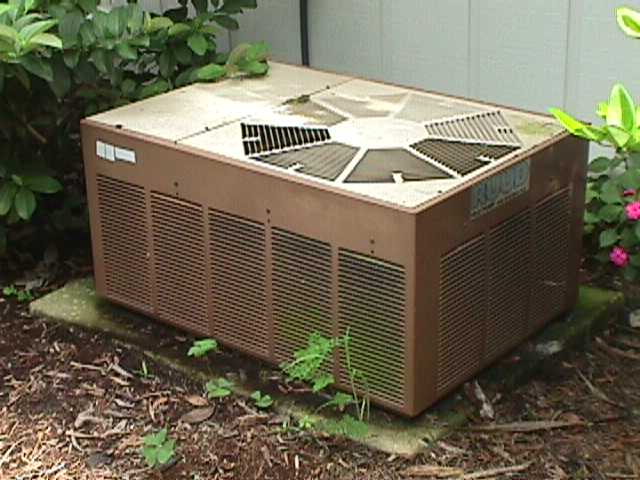
Air Conditioner Energy Use
Most homes in Florida have central air conditioners which represent a very large energy end-use. Of the 167 single-family homes in the base sample in the residential monitoring project, 97% had central air conditioning systems. Within the statistically selected sample, total annual electricity use averaged 17,130 kWh. Of this total 6,421 kWh (37%) was used for cooling and 1,070 kWh (7%) for space heating (Parker, 2002).
Air Conditioner Retrofits
Several field studies have shown that a 20 – 40% energy savings can be achieved by replacing less efficient AC units with higher ones (Parker, 1990; Burns and Hough, 1991; Ternes and Levins, 1992). These studies suggest that savings are strongly influenced by pre-retrofit consumption, with the highest users the most cost effective to improve. Energy savings were found to scale reasonably well to the change in the pre and post SEER of the appropriate equipment. However, SEER rating is not necessarily an accurate predictor of AC peak kW (Proctor et al., 1994). Proper sizing of replacement equipment is also critical for reducing utility coincident peak loads (Neal and O'Neal, 1994).
Over the past decade, Florida utilities have sponsored many programs to install more efficient central air conditioners and heat pumps. However, few programs have monitored the impact of these changes to both monitored energy use and summer peak demand. Further, few if any studies have examined changes to occupant comfort from such retrofits.
Our project evaluated AC retrofits in five case-study homes where air conditioning power, interior temperatures and weather conditions were recorded. All project homes were metered for a full year prior to the AC retrofits in order to allow matches in month-long weather between the pre and post intervention periods. Three types of AC retrofits were performed: (1) change to higher efficiency single-speed equipment; (2) change to single-speed outdoor unit with a variable speed indoor unit and (3) change to two-stage outdoor compressors with a variable speed indoor blower. Variable speed indoor units are attractive in Florida since lower fan power increases efficiency while providing enhanced humidity removal through fan speed modulation.
To analyze this data we created three graphical evaluations for each site. First, a scatter plot shows the average daily air conditioning consumption in the existing AC system compared with the retrofit system against the site measured interior to exterior temperature difference. A second plot shows AC power demand and interior temperature profiles for month long periods in the pre and post period with matched weather conditions. Average peak demand was defined as the maximum daily average hourly AC electricity requirement over month-long summer periods.
However, the summer peak demand comes when the utility experiences its peak summer system-wide demand during an hour. This came on August 30, 1999 prior to the retrofits and on August 8, 2000 after the retrofits were in place. The utility system peak came at 5 – 6 PM EDT (4-5 PM EST) on both days. Thus, for each AC retrofit, we show a third plot of the utility peak day before and after the retrofit, summarizing the peak hour demand reduction.
Site #197: Variable Speed Air Handler: 3-ton system
Site #197 is a 1,764 square foot older home built in 1963, located in St. Petersburg and occupied by a family of six. The home has R-12 ceiling insulation and uninsulated concrete block walls. The roofing was originally white tile, changed over to white shingles. The homeowner maintains 79 oF inside during summer and 72 oF inside during colder winter period. The homeowner had the AC system replaced on June 9, 2000. The original system was older less efficient, General ElectricBGWC030A1D01, packaged 2.5 ton AC (combination condenser and evaporator) which drew over 4 kW at full output. This was nominally about a 7.0 EER system. The new unit was a 3-ton Trane XE1200 with a variable speed TWE037E air handler. The combination has a rated SEER of 13 Btu/W. This was the only site of the three single speed AC system retrofits which used a variable speed air handler. Figures 1 and 2 show, the energy and demand reductions at his home are very large. Figure 3 shows the performance on the utility peak days before and after retrofit.
Figure 1. Average AC Demand Profile for Site #197 Pre & Post

Figure
2. Site #197 of Average Daily AC Consumption Against
Exterior
to Interior Temperature Difference

Figure 3. Average Utility Peak Day Demand Profile for Site #197 Pre and Post

Despite that the homeowner maintained an average 0.4 ºF cooler temperature in August, the XE1200 with the variable speed air handler produced an average daily peak demand reduction of 2.43 kW (69%) and a cooling energy reduction of 45.7 kWh or 72%. Even on the post retrofit utility peak day, a 60% coincident peak hour demand reduction (2.54 kW) was seen. This is a good illustration of the advantage of the variable speed air handler.
Site #26: (4-ton, single-speed system)
Site #26 is a 2,118 square foot home built in 1963, located in Casselberry, FL and occupied by a family of four. The home has R-8 ceiling insulation, a roof with dark asphalt shingles and uninsulated concrete block walls. The AC retrofit was performed on May 26, 2000. The original unit was a very old Armstrong 3.5 ton system, was replaced by a new Intertherm T3BC 048K 4-ton heat pump with a matching constant speed air handler (B3BV-060K-C) . At full load the total system draws 4.3 kW (3.7 compressor, 0.6 kW on the air handler). The annual cooling consumption before the change out in 1999 was higher than any other monitored site (12,778 kWh).
The comparative load data from June 1999 and June 2000 (Figures 4 and 5) reveals that while comfort improved (1 oF) and 36% energy savings (29.7 kWh) were achieved, average peak demand was reduced slightly by 4% (0.18 kW). This is disadvantageous to the utility as energy is reduced but demand is relatively unaffected. Part of this comes from take-back with the larger installed unit (0.5 tons) used to achieve greater comfort during the peak period. This emphasizes the hazards of up-sizing systems within utility AC replacement programs.
Figure 6 shows the performance on the utility summer peak day in 1999 compared with that in 2000. The older unit ran constantly the peak day before the change and was only able to maintain an interior temperature of 79-81 ºF. After the change, the new AC system also runs constantly during the peak hour, but draws 1.3 kWh (26%) less.
Figure 4. Average AC Demand Profile for Site #26 Pre & Post

Figure
5. Site #26 of Average Daily AC Consumption Against
Exterior
to Interior Temperature Difference

Figure 6. Average Utility Peak Day Demand Profile for Site #26 Pre & Post

Site #36: 3-ton single-speed system
Site #36 is a modest 991 square foot home built in 1963, located in Seminole, Florida and occupied by a middle-aged couple. The home has R-12 ceiling insulation under a roof with dark asphalt shingles and uninsulated concrete block walls. The homeowners maintain 79-80 oF inside and 67 oF in winter. The home owner replaced the existing air conditioner on June 15, 2000. The old unit was an Arcoaire WH0276AALE 2-ton water-to-air heat pump which drew about 3.2 kWh when running constantly. The system was replaced a single-speed 3-ton unit which draws 3 kW when running constantly (2.5 kW compressor, 0.5 kW air handler).
Figures 7-9 show the performance in July of 1999 with the old system and July of 2000 with the new one. As with the other retrofits, the household enjoys better comfort (0.3 oF cooler) with the new system. Energy savings are also respectable at 26% (11.5 kWh) with an average summer day demand reduction 25% (0.77 kW). The utility peak day demand reduction during the peak hour in August was greater, 1.26 kW or 39% due to constant run of the older system under very hot weather conditions.
Figure 7. Average AC Demand Profile for Site #36 Pre & Post

Figure
8. Site #36 of Average Daily AC Consumption
Against
Exterior to Interior Temperature Difference

Figure 9. Average Utility Peak Day Demand Profile for Site #36 Pre & Post
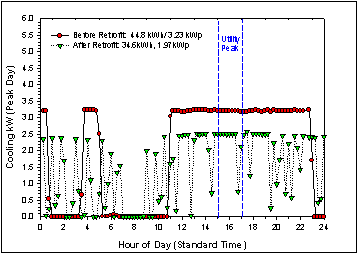
Air Conditioner Replacement with Two-Compressor Cooling Systems
Two sites featured change out of the existing air conditioning system to a high-performance two-stage compressor cooling system developed by the Trane Company. These systems have nameplate SEERs up to 18 Btu/Wh when used with a variable speed air handler. Since the second stage cooling can be radio controlled with utility load control switches, this becomes an attractive option where second-stage cooling can be locked out during peak periods, but the customer continues cooling during the control window with primary stage operation.
Site #75
The first two-stage cooling system was installed at Site #75. This is a 2,363 square foot home built in 1982 in Clearwater, Florida and occupied by an older couple. The home has concrete block walls with R-3 insulation and R-19 ceiling insulation under gray asphalt shingle roofing. The homeowners maintain a set point of 75 oF inside during summer and 70 oF inside during winter. The original unit was an old 4-ton system of uncertain make which drew 5.9 kW (5.3 compressor, 0.6 kW on the air handler). Manual J indicated a 41,300 Btu/hr total cooling capacity. The AC unit was changed out on (Site #75) on July 24 th, 2000. The old unit was replaced by a new Trane TWZ048A 4-ton, two-stage heat pump with a matching air handler TWE065E13FB. Figure 10 is a time series plot showing the energy use and demand during six days after the system was changed.
Figure 10. Change in AC Demand and Energy with AC Replacement at Site #75
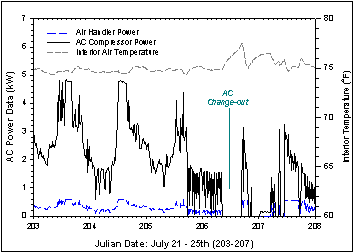
A month-long composite plot is shown in Figure 11, illustrating the site performance from June 23 - July 23, 1999 with the old system and July 25 - August 25th 2000 with the new one. The occupants maintained almost exactly the same temperature pre and post the system measurements and average weather conditions were well matched. Energy savings are very large at 47% (29.0 kWh/day) with an average summer day demand reduction of 37% (1.50 kW). A scatter plot shows a significant change to the slope of the daily cooling energy against the outside air temperature difference (Figure 12). Figure 13 shows a 32% demand reduction (1.61 kW) on the utility peak day during the system coincident peak hour.
Figure 11.Average AC Demand Profile for Site #75 Pre & Post
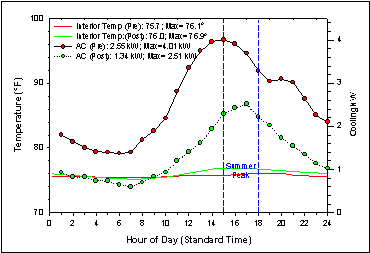
Figure
12. Site #75 of Average Daily AC Consumption Against
Exterior
to Interior Temperature Difference
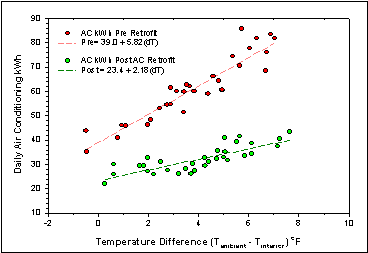
Figure 13. Average Utility Peak Day Demand Profile for Site #75 Pre & Post

Site #38
The second two-stage cooling system was installed at Site #38. This is a 1,827 square foot home built in 1973, located in Winter Park and occupied by a family of three. The home has R12 ceiling insulation and uninsulated concrete block walls. The roofing consists of brown asphalt shingles. The existing AC unit was a 17 year old Janitrol 3- ton system. The garage air handler was a Rheem RENB1415JRS. The homeowners claimed to maintain a set point of 78 oF inside during summer and 70 oF inside during winter. However, examination of the temperature maintained inside the home showed the customers were actually trying to maintain 74-76 oF. The original AC system draws 4.2 kW (3.7 compressor, 0.5 kW on the air handler).
Manual J was used to size the replacement air conditioner, indicating a 27,000 Btu/hr unit. The AC unit was changed out on (Site #38) on August 21st, 2000. The old unit was replaced by a new Trane TWZ036A 3-ton, two-stage heat pump with a matching air handler TWE040E13. A plot of the AC demand during the two weeks before and after the new system installation is shown in Figure 14. It shows a very large impact on space cooling demand.
Figure 14. Impact on AC Electric Demand of Change Out at Site #38
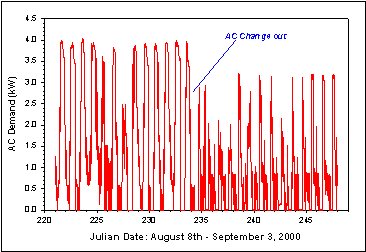
A month-long matched-weather composite demand plot is shown in Figure 15. This compares the performance at Site #38 in July 20- August 20th with the old system and August 22 - September 22nd 2000 with the new one. As with the other retrofits, Site #38 household enjoys better comfort (0.7 oF cooler) with the new system. Energy savings are very large at 59% (21.4 kWh/day) and similarly, a 44% (1.46 kWh) reduction in average summer day maximum demand. The scatter plot in Figure 16 shows a very large change to the slope of the AC demand against the outside air temperature difference. However, it was not possible to perform a comparison of the utility peak days pre and post as the new unit was not installed until after the peak day in 2000. Interestingly, however, the peak demand of the old unit on the two successive peak days was very similar – 3.7 kWh in 1999 and 3.9 kWh in 2000. As apparent from Figure 14, a large demand reduction would likely have been seen were the unit replaced earlier.
Figure 15. Average AC Demand for Site #38 Pre & Post
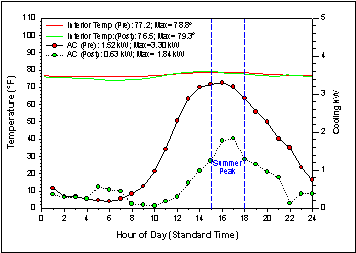
Figure
16. Site #38 of Average Daily AC Consumption
Against
Exterior to Interior Temperature Difference
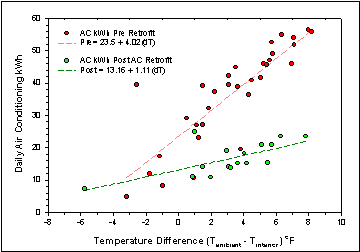
Impact of Air Conditioner Retrofits
A clear feature of the AC retrofits was that each produced savings with largest reductions on the hottest days – a positive attribute for utilities. The difference was greatest for the three systems with the variable speed air handler or VSAH (Sites #197, #38 and #75). Sites #38 and #75 have the two-compressor cooling system also with variable speed air handlers. Theoretically, these systems will allow even greater demand reduction than the 30-40% already being achieved since the second stage cooling could be interrupted during load control periods by radio control signal.
Table 3 offers a comparative evaluation of the two conventional air conditioner retrofits and three others which include the variable speed air handler. Two of the later feature the two-stage air conditioning system. Although case studies, systems with the VSAH look to produce both energy and demand savings in the 40 - 50% range when compared with replacement of older equipment. The energy savings for conventional equipment looks to be lower – in the 30% range.
Variable speed air handlers offer other advantages in residential application. For instance, their electronically commutated motors (ECMs) are 15% more efficient at full speed and offer electric demand reduction even under full load operation. Further, they adapt to changes in fan static pressure to provide rated indoor coil air flow, improving cooling performance. They are also much more efficient at slower speeds such as those experienced during heating conditions. They are typically set up to yield a slow start, providing more quiet operation with greater humidity removal at slower fan speeds. As observed by Khattar et al. (1985) and more recently by Shirey and Henderson (2004), the modulation of fan speed with loner compressor run times can be particularly desirable in hot-humid climates.
Table
3
Air Conditioner Retrofit Performance Results
| Conventional AC Retrofits | |||
| Site | Daily Avg. AC Use | Daily Avg. Peak Demand | Utility Peak Hour Demand |
| Site
#36 (Pre) (Post) Savings |
41.0
kWh 29.3 kWh 11.7 kWh (29%) |
2.70
kW 1.90 kW 0.80 kW (30%) |
3.23
kW 1.97 kW 1.26 kW (39%) |
| Site
#26 (Pre) (Post) Savings |
85.4
kWh 56.6 kWh 28.8 kWh (34%) |
4.15
kW 3.95 kW 0.20 kW (5%) |
5.03
kW 3.70 kW 1.33 kW (26%) |
| Variable Speed Air Handlers | |||
| Site
#197 (Pre) (Post) Savings |
57.4
kWh 27.4 kWh 30.3 kWh (52%) |
3.38
kW 1.74 kW 1.64 kW (49%) |
4.23
kW 1.69 kW 2.54 kW (60%) |
| Site
#75 (Pre)* (Post) Savings |
61.2kWh 32.2 kWh 29.0 kWh (47%) |
4.01
kW 2.51kW 1.50 kW (37%) |
5.06
kW 3.45 kW 1.61 kW (32%) |
| Site
#38 (Pre)* (Post) Savings |
36.5kWh 15.1 kWh 21.4 kWh (59%) |
3.30
kW 1.89 kW 1.46 kW (44%) |
3.69
kW NA NA |
* Two compressor cooling system
Conclusions
A Florida utility monitoring project found air conditioner retrofits can provide large energy savings and significant reductions to summer day peak demand. Two evaluated retrofits had older single-speed AC systems replaced with the same type, but of newer vintage. Here the cooling savings were 29% and 34%, with an average savings of 20.2 kWh/day. The reduction in average daily summer peak demand was 30% and 5% respectively, with an average reduction of 0.30 kW. An appreciable amount of customer comfort take-back was observed with lower demand reduction – particularly in the second site where the newer unit was sized larger. Although case study results indicate typical energy use and demand savings from conventional AC replacement are about 25%, it also suggests that proper sizing of retrofit equipment may be vital to achieving effective utility coincident peak demand reduction.
In a second part of the pilot project, three customers’ units were replaced with very high efficiency air conditioners. One system featured a SEER 13 system with single-speed compressor coupled with a variable speed air handler (VSAH). Measured cooling energy was cut by 52% (30.3 kWh) with a 49% reduction to average demand (1.64 kW). Two additional sites had the VSAH matched with a two-compressor AC system with seasonal efficiencies over 17 Btu/Wh. Average electrical consumption in these two sites was cut by 47% and 59% percent respectively (29.0 and 21.4 kWh/day), with reductions to average daily maximum demand of 37% and 44% (1.50 and 1.46 kW). Reductions to utility coincident peak demand were even greater. Our case studies indicate high-performance AC systems with VSAH can achieve energy savings averaging about 50% with reductions to peak demand of 35-50%.
In conclusion, air conditioner retrofits show promise to significantly reduce cooling energy and demand. Systems with variable speed air handlers showed largest impacts to both energy and peak reductions and could form the basis for effective utility programs to help control summer afternoon peak demand. Variable speed air handlers also have the side benefits of better adapting to changes in duct static pressure to provide rated air flow, more quiet operation and potentially improved moisture removal in humid climates.
Acknowledgement
Special thanks to Progress Energy Florida, Inc. for their willingness to share information of value to the larger residential energy efficiency community.
References
Burns, R. and Hough, R.E., 1991. Monitoring and Evaluation of Replacing Low-Efficiency Air Conditioners with High-Efficiency Air Conditioners in Single-Family Detached Houses in Austin, Texas, ORNL/Sub/86-SA566/V, Oak Ridge National Laboratories, Oak Ridge, TN.
Khattar, M., Ramanan, N. and Swami, M., 1985. "Fan Cycling Effects on Air Conditioner Moisture Removal Performance in Warm, Humid Climates," International Symposium on Moisture and Humidity, FSEC-PF-75-85, Florida Solar Energy Center, Cape Canaveral, FL.
Neal, L. and O'Neal, D. "The Impact of Residential Air Conditioner Charging and Sizing on Peak Electrical Demand," 1994 ACEEE Summer Study on Energy Efficiency in Buildings, Vol. 2, American Council for an Energy Efficient Economy, Washington D.C..
Parker, D.S., 2002. “Research Highlights from a Large Scale Residential Monitoring Study in a Hot Climate,” Proceedings of the International Symposium on Highly Efficient Use of Energy and Reduction of its Environmental Impact, Osaka, Japan.
Parker, D.S. "Monitored Residential Space Cooling Electricity Consumption in a Hot-Humid Climate," 1990 ACEEE Summer Study on Energy Efficiency in Buildings, American Council for an Energy Efficient Economy, Washington D.C., Vol. 9, p. 253, 1990.
Proctor, J., Katsnelson, Z., Peterson, G. and Edminster, A., 1994. Investigation of Peak Electric Load Impacts of High SEER Residential HVAC Units, Prepared for Pacific Gas & Electric, San Ramon, CA.
Shirey, D.B., and H.I. Henderson, 2004. "Dehumidification at Part Load", ASHRAE Journal, Vol. 46, No. 4, April, 2004.
Ternes, M. and Levins, W., 1992. Oklahoma Field Test: Air Conditioning Electricity Savings from Standard Energy Conservation Measures, Radiant Barriers and High-Efficiency Win-dow Air Conditioners, ORNL/CON-317, Oak Ridge National Laboratory, Oak Ridge, TN.
